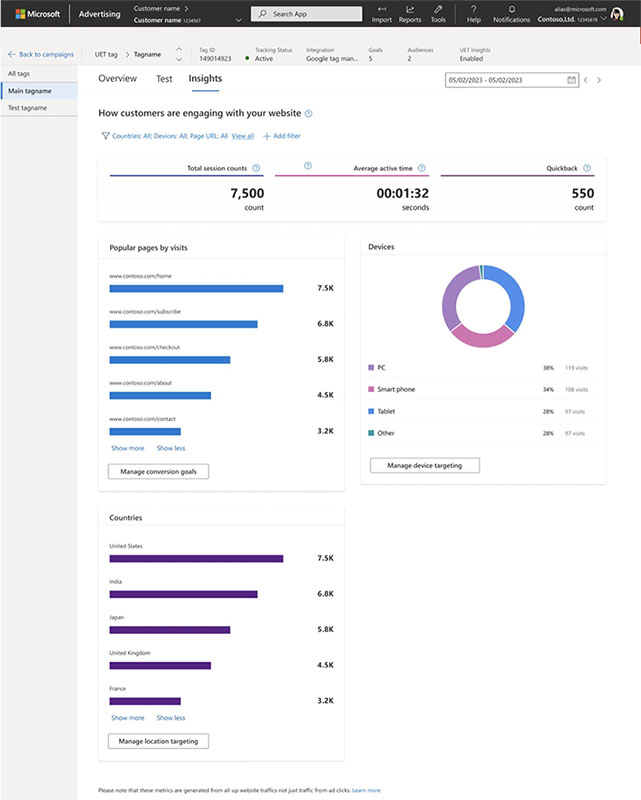Understanding how users engage with a website is essential for any business, especially when assessing the effectiveness of advertising efforts.
To assist advertisers with this, Microsoft introduced new insights for Universal Event Tracking (UET) tags designed to meet these business requirements more effectively and boost website traffic and conversions.
Scheduled for rolling activation starting on July 3, this feature will automatically be enabled for existing UET tags.
Notably, UET Insights incorporates enhanced data collection methods aimed at delivering valuable insights to users and honing the precision of ad targeting.
What Is A Microsoft UET Tag?
A Microsoft Advertising UET tag keeps track of the customer activities on your website after clicking on your ad. It embeds a single UET tag across your website, enabling Microsoft Advertising to gather pertinent data.
Such data collection empowers you to monitor conversion objectives and create specific remarketing lists to target audiences more effectively.
The UET enables tracking various conversion goals, including purchases, sign-ups, downloads, and more. The conversion goals can be configured based on the following criteria:
- The count of visitors who visited a particular page or section on your website.
- The instances when visitors have spent a specific length of time on your website.
- The cases where visitors have browsed more than a particular number of pages on your website.
- The tally of individuals who have clicked on and installed your mobile application.
Along with these, several other custom goals and events can be set up and tracked.
What The New UET Insights Have To Offer
The newly introduced insights feature several advancements, aiming to provide a more in-depth understanding of website user interactions.
UET Insights come with a powerful built-in dashboard for website data, streamlining the understanding of user engagement. This feature allows businesses to fine-tune their webpages and optimize targeting for enhanced conversions.
 Screenshot from Microsoft, May 2023
Screenshot from Microsoft, May 2023The dashboard showcases crucial data, such as:
- The overall visits to your website and the number of visits each page has received.
- A breakdown of sessions based on the country of origin and device type.
- Data on quick backs, which refers to customers who spend only a few seconds on your website.
- Information on the duration visitors spend on your website.
These insights include additional indicators like page latencies, encompassing speed and load times, interactions such as clicks and scrolls, specifics of purchase carts, details related to cart abandonment, browser-related signals, and JavaScript browser errors.
How UET Insights Helps Advertisers
The benefits of UET Insights should extend beyond providing a thorough comprehension of your website’s performance.
They should help advertisers enhance the effectiveness of ads through refined targeting, fraud detection, and minimizing conversion loss.
All these factors contribute to a richer understanding of user behavior and website performance, leading to more efficient advertising strategies.
What Advertisers Need To Know
Activating UET Insights doesn’t require coding. Existing tags will be automatically updated on the backend, while any new tags created in the future will be pre-equipped with UET Insights.
Here are some other essential aspects to note:
- UET Insights are designed in a way that ensures there’s no adverse effect on your site’s performance.
- The collected data is processed and presented almost instantly on the UET dashboard.
- There’s no data sampling involved, ensuring that the information you receive is complete and representative.
- Advertisers maintain full control over UET Insights and can choose to turn them off if needed.
For a more in-depth understanding of this feature, it’s recommended to check out the help page provided by Microsoft.
If advertisers want to disable UET Insights for any reason, they have a couple of choices.
Before June 28, advertisers can choose to forgo the automatic upgrade by filling out the opt-out form. They’ll need to provide either the specific UET tag IDs they wish to exclude or the Manager Account ID if they plan to opt out of all UET tags associated with that Manager Account.
Should advertisers decide to opt-out after UET Insights has been activated, they can do so conveniently through the UET Dashboard in the Microsoft Advertising platform.
Featured image: sdx15/Shutterstock
 seolounge
seolounge